There is a whole group of cucumbers called bush. However, as a separate cultivar “Kustovoi” was bred back in the USSR, specialists from the agricultural company “Search” and the Federal State Budgetary Institution. It was included in the state registry of the Russian Federation in 1980. From the characteristics with the description it follows that Kustovoi is not a hybrid. It was created for cultivation for personal purposes on open soil. It is not suitable for greenhouses. According to reviews, it is well recommended in the territories of all CIS countries. Photos taken by summer residents, this only confirms.
Content
general characteristics
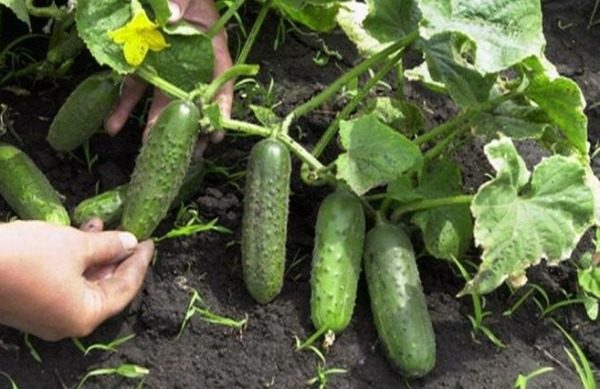
The main difference between the bush from other varieties is the shape of the lashes. In this regard, the cucumber is more like a zucchini. It grows with a bush, several shoots come from the root at once. The length of the lashes almost never exceeds half a meter. The plant does not need regular pinching of lateral shoots and formation. The leaves are deep green, medium-sized, densely planted.
The ovary is laid next to each leaf. Flowers are mainly female. The variety is bee pollinated, so it must be grown on open ground, where insects have access to it. The use of film shelters is possible only in the initial stages.
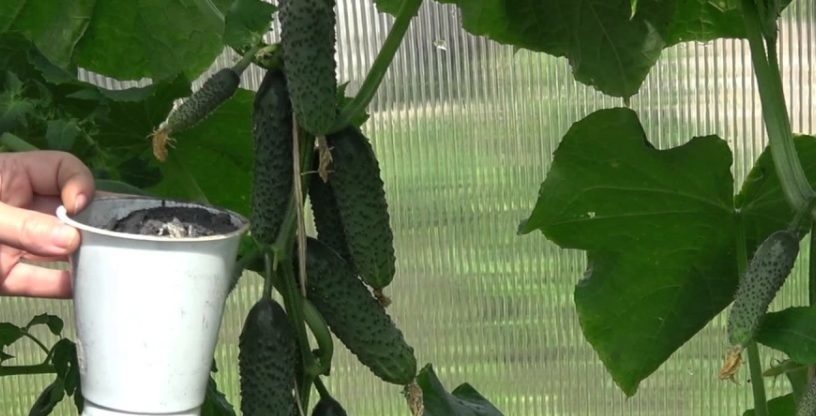 You may be interested in:
You may be interested in:The variety, although declared as early ripe, it can be removed from it in 45-50 days after the first germination, which is more typical for mid-ripe cucumbers. The plant gives the main crop within 3 weeks. Productivity depends on weather, soil quality, care and insect activity. On average, it is 5-6 kg per 1 sq. Km. m. The length of the vegetables is 8-12 cm, and the weight is about 100 g. Although, of course, the gardener can collect the gherkins after they reach the length of 7-8 cm or let the fruit ripen completely and reach a length of 25 cm and a weight of 300 g.
The fruits of Bush bush are no more than fruits of any other variety. The peel on the cucumbers is thin and delicate. The vegetable is suitable for salads and salting with a short shelf life. With prolonged storage, the vegetable becomes soft and tasteless. You can’t preserve cucumbers for sealed lids in a jar, since in this case there is a high risk of a lid swelling.
Advantages and disadvantages
Kustovoi variety has much more advantages than disadvantages. These can be listed:
- Endurance. The variety is undemanding to soil and tolerates heat, drought, strong winds more easily than others. It can be planted in remote areas when there is no way to care for the plant constantly. Although, of course, with more careful care, the yield will be higher.
- Easy care. The plant does not need to be planted, tied to trellises and form a bush. The shoots are not intertwined with each other and therefore they are well shined by the sun and ventilated. As a result, the likelihood of developing diseases is reduced. The plant does not need any special top dressing, except for those recommended for all cucumbers, without exception.
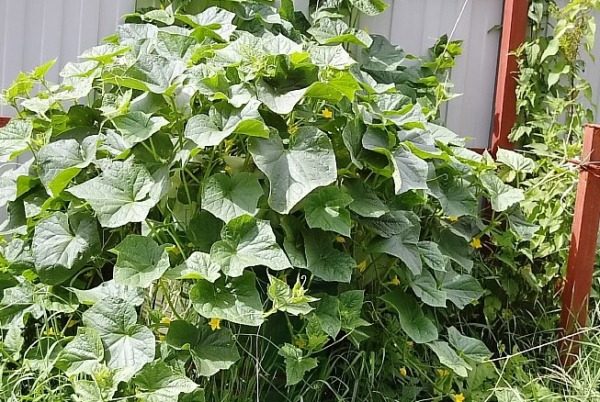
- Early harvest, fruit ripening together. The plant manages to give the crop until mid-summer, when all kinds of diseases begin to develop on some plants due to heat and humidity. Thus, the risks of losses are reduced.
- Drought tolerance.The plant does not need frequent and plentiful watering, as its medium-sized wattle fumes evaporate and require much less liquid than other varieties. In dry and hot weather, it is sufficient to maintain the soil under the bush in a slightly moist state.
The main disadvantage of this variety is the lack of the ability to grow it in greenhouse conditions. The fact is that Kustovoi needs bee pollination, and it is difficult to open access for pollinating insects to it, while maintaining the microclimate. In addition, Kustovoi is not able to produce the same rich crop as modern tall hybrids designed for cultivation in closed conditions.
Cucumbers with a long lash can build up a new lash, on which later the ovary will also form, that is, an additional crop. Kustovoy forms the first, spring ovaries on his short lash, on which fruiting will end. Therefore, this variety is not worth growing for farmers who want to earn on the sale of vegetables. It’s simply not profitable to occupy the area of greenhouses.
Sustainability
All bush plant varieties are highly resistant to disease. The Bush variety is not predisposed to the development of various types of rot (including root), bacteriosis. However, he is defenseless against powdery mildew and peronosporosis. The causative agents of these diseases are pathogenic fungi. As a result of their activity, gray-brown patches are formed on the leaves, which in structure are similar to felt or velvet.
You can fight this problem with the help of serum. She needs to irrigate the leaves and shoots. Similarly, plants can be treated with soapy water. In advanced cases, the use of fungicides (for example, Fitosporin or Quadris) is justified. Pathology is spreading rapidly and if left untreated, it can quickly destroy all plantings.
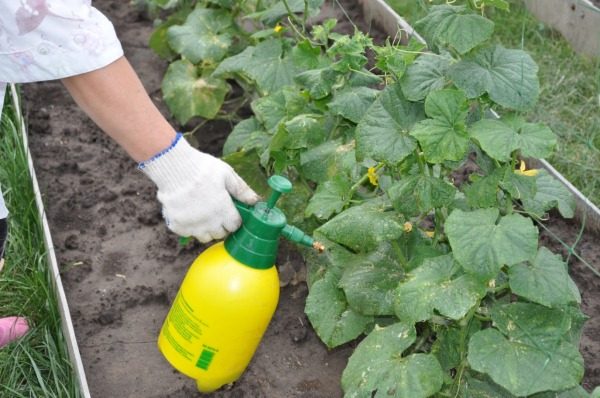
In addition, plants can damage insect pests and their larvae. Most often this happens in aphids. Although these winged green or black insects are small in size, it is not difficult to consider them. Usually whole clusters of aphids are found on the bush. She sucks the juice from the plants, causing them to die. Solve the problem will help ash mixed with chalk in equal amounts. This agent should be used to powder affected specimens.
Another no less common pest is a spider mite. The ideal environment for it is moist, weedy soil. When a plant is affected by ticks, the entire bush is covered with white cobwebs produced by the special glands of the insect.
Landing
Since the Bush variety is bee pollinated, the seeds in it are obtained complete. Therefore, many summer residents prefer to independently collect seed material from the grown crop. Two types of seeds are sold in specialized stores: regular and processed, coated. The latter option can be used immediately. They do not need preparation before landing. The shells contain growth stimulants, pesticides (protect against diseases and parasites) and nutrients. Due to this, seed germination is increased by 10%, and yield by 20%. In addition, it provides pest protection.
As bush designed for open groundYou can plant it in two ways. The first is the transplanting of seedlings in mid-spring. To do this, the seeds must be placed in a nutrient substrate. The first shoots should appear about a week after that. The soil should always be moist. It needs to be moistened by spraying from a spray bottle. Then loosen. This must be done carefully so as not to damage the root system.
In mid-May, when the probability of frost decreases, seedlings can be transplanted to a permanent place. The distance between the cucumbers in the row should be 30 cm or more, and between the rows - from half a meter. It is advisable to prepare the soil in advance. In the autumn, carefully dig and mix with horse or cow manure. In the spring, it is useful to pour ash into the holes.
Further care and harvesting
Water the plants either immediately after sunrise, or shortly before sunset. During the day, moisture will evaporate, and damage the leaves and fruits. Before watering, you need to let it stand in the sun so that it warms up. Cold liquid can cause root rot and death of the plant. You need to pour water strictly under the root. It is important to avoid getting liquid on the leaves and shoots, as then it will burn tissue like a lens. After watering, the earth needs to be loosened.
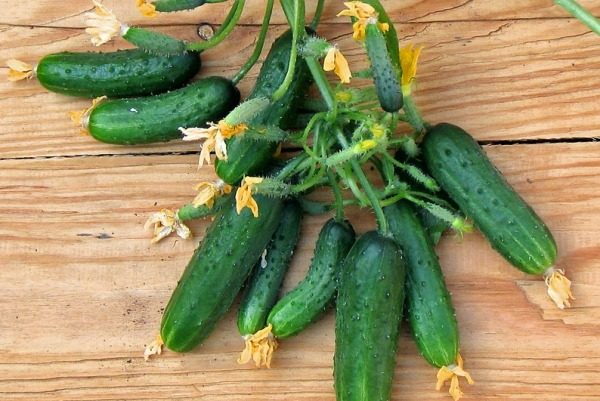
To increase the yield of the plant, you need to resort to top dressing. A week after the first shoots, potash fertilizers should be applied. This will stimulate the growth of young plants and help strengthen the roots. When growing cucumber seedlings, the first fertilizer should be done a little earlier. Agronomists advise feeding at different periods of plant vegetation.
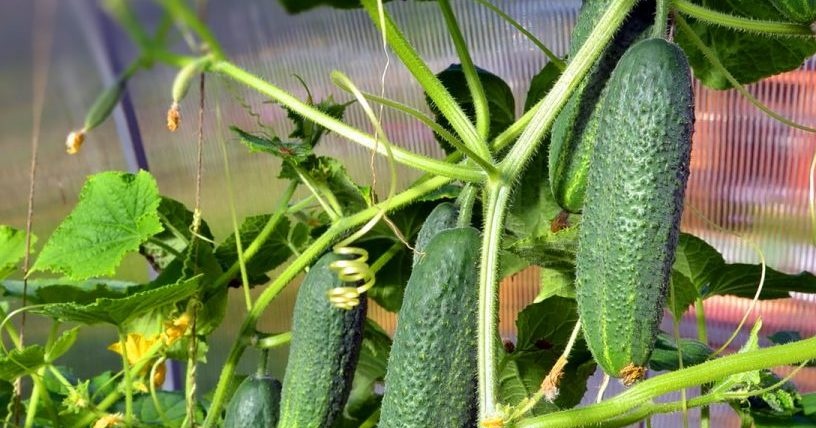 You may be interested in:
You may be interested in:It will be optimal to choose the following time:
- The period of active growth of shoots. It is necessary to mix 15 g of ammonium nitrate with the same amount of potassium chloride and 30 g of superphosphate. Dissolve the mixture in a bucket of water and pour it under the bushes.
- Flowering period. It is necessary to mix 500 ml of mullein infused for two weeks with 1 tbsp. l nitrofoski and pour a bucket of water. With weak flowering, another 0.5 g of boric acid can be added to the product.
- The ripening period of vegetables. Chop any young grass and fill it with water, let it brew for 10 days. Then mix 1 liter of this infusion with ash and pour 10 liters of water.
Before feeding, beds need to be carefully watered with plain water. This will prevent root burns from fertilizer components. Additionally, it is necessary to use foliar top dressing. For this, superphosphate, potassium nitrate, boric acid and zinc sulfide can be used. These substances need to be dissolved in water, and then spray plants with it.
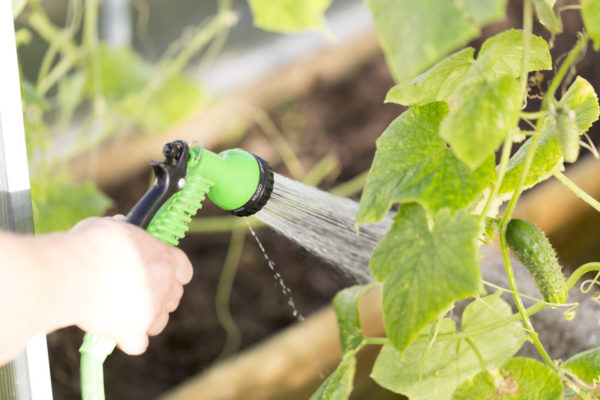
You need to harvest every 2-3 days. If this is not done on time, the bush may break under the weight of the fruit, which will entail premature death. In addition, regular frequent harvesting stimulates the growth of new fruits. Greens should be collected carefully, being careful not to damage the plant. To do this, you can use scissors. Along the way, it is recommended to remove the yellowed foliage. You can store cucumbers in the cellar near the liquid container or in the refrigerator. Shelf life - no more than a week.
Reviews
Victor, 48 years old
Last year, planted several cucumbers of this variety. I liked that the bush does not grow much. The plant does not need to be tied up, and the fruits are convenient to collect. The good news is that Zelentsy is stored for a long time and does not deteriorate. To get a plentiful harvest, every 2 weeks he watered the plants with milk half-diluted with water. As a result, the bushes did not hurt, and the yield was average. In principle, I grow them for myself, and not for sale, and that was enough for me.
Michael, 32 years old
We have grown this variety for many years.For our small plot, it is great. Even the grown bushes do not take up much space. Two years ago, in order to save water, the cucumbers were mulched with sawdust. From this damp, and the plant began to hurt. Last year we bought a drip irrigation system, and I still can’t get enough of it. With such irrigation, water consumption is reduced, and the earth remains wet longer. So it was possible to save water, and to avoid diseases of cucumbers.
For the cultivation of Bush does not need special knowledge and experience, so it can be recommended even to gardeners, beginners. The plant is hardy and completely unpretentious. It has a high phytoimmunity. The plant yields to hybrids in productivity, but not in the saturation of taste and aroma. Agronomists claim that Kustovoi is one of the most healthy and delicious varieties at the moment.




 Armenian cucumber with melon flavor: description and characteristics, reviews
Armenian cucumber with melon flavor: description and characteristics, reviews Do-it-yourself vertical beds for cucumbers: schemes, photos
Do-it-yourself vertical beds for cucumbers: schemes, photos Hollow cucumbers: reasons for the appearance of hollow, what to do
Hollow cucumbers: reasons for the appearance of hollow, what to do Which manure is best for cucumbers: application, how to breed
Which manure is best for cucumbers: application, how to breed